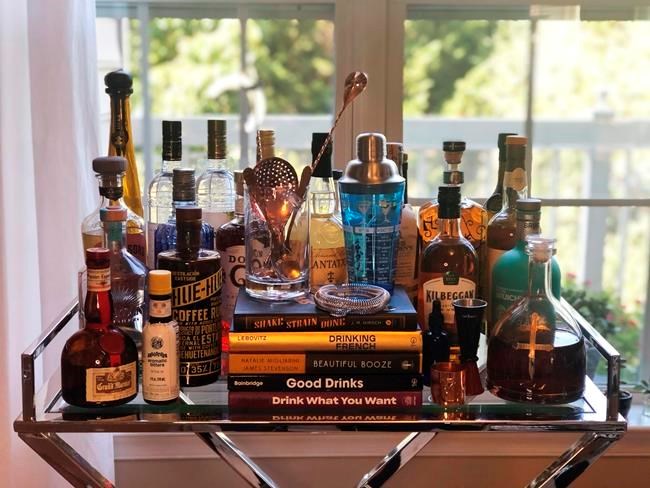Cocktails are having a moment, and because of the pandemic, that moment is happening most often at home.
Many restaurants have responded with cocktails to go, approved in more than 30 states, according to the Distilled Spirits Council, an industry trade group. Liquor stores offer cocktails-in-a-can, like those from Canteen and Cutwater, as well as hard seltzers and more.
But there's also been a rise in home bartending, with a number of books on the subject released in the past six months.
Unlike the often complicated cocktail books of the past, these five offerings by new-to-the-cocktail-world authors are written specifically for the home cook/bartender. Each aims to help you experience craft cocktails at home without having to get a Ph.D. in mixology.
___
“Beautiful Booze: Stylish Cocktails to Make at Home” (Countryman Press) is written by Natalie Migliarini and James Stevenson, who left Seattle five years ago to travel and document the world of wine, beer, spirits and liqueurs. The inviting and glamorous photographs were shot in a rented apartment in New Orleans.
The book grew from a blog of the same name, and the recipes are simple (often three ingredients), visually appealing and refined. The authors renamed classic cocktails and gave them a witty twist for a book that is as much fun to read as it is to drink from.
___
John DeBary worked for years in the New York City bar business. He is a wine and spirits writer and also launched the non-alcoholic aperitif Proteau about a year before the release of his book, "Drink What You Want: The Subjective Guide to Making Objectively Delicious Cocktails” (Clarkson Potter). The title resonates with me because I have always given the same advice, regardless of the recommended pairings.
DeBary offers recipes for both alcoholic and nonalcoholic cocktails, some with clever names and absolutely no pretension. The writing is straightforward and informative. If you know nothing about how to make a drink, you can learn it all here. And if you already fancy yourself a home bartender, you'll pick up tips and new ideas.
___
J.M. Hirsch, the editorial director of Milk Street and former food editor for The Associated Press, turned a beloved hobby into a cocktail book, “Shake, Strain, Done: Craft Cocktails at Home” (Voracious). He approaches cocktails from a culinary perspective, breaking them down according to 11 categories: refreshing, creamy, fruity, sweet, sour, herbal, bitter, spicy, smoky, warm and strong.
Hirsh presents drinks in a “language that we can taste.” You can peruse the book for a primary liquor, like bourbon, and for a dominant characteristic. So, for instance, if you want a refreshing vodka drink or a warm bourbon tipple on a cold night, the book will guide you.
___
If you are missing the City of Light and yearn for some café culture, David Lebovitz shows you how to create it yourself at home. The pastry chef and cookbook author’s newest book is “Drinking French” (Ten Speed Press). The photography alone transports you back to Paris. Lebovitz has captured traditional drinks, created some new ones and rediscovered iconic French spirits such as Suze, Pineau de Charentes, cognac, Chartreuse, Armagnac and Byrrh.
Since the book was released in March, Lebovitz has been demonstrating food and drink on Instagram with his “apéro hour” videos. The apéro hour “signals the transition between day and night, or work and play,” he explains. In France, it is a time to wind down, and enjoy an aperitif and a nibble.
___
Julia Bainbridge is a food writer who decided to stop consuming alcohol but not to stop drinking. She drove cross-country in pursuit of the best non-alcoholic craft cocktails that she could find.
Her new book, “Good Drinks: Alcohol-Free Recipes for When You’re Not Drinking for Whatever Reason” (Ten Speed Press), is welcome for those who want to enjoy a spirit-free cocktail to celebrate and join in the fun.
___
Before you start experimenting with the drinks in these books, make sure you have the basics on hand.
As you try new cocktails, you will build your bar based on what you like. Don’t feel you have to go out and buy everything at once. My starter list includes aged versions of tequila, rum and whiskeys from around the world, because I am a brown spirits lover. It will likely be different for your bar.
For example, if you are a gin drinker, experiment with the new craft gins available. There are so many fantastic spirits and liqueurs available today that it is almost a requirement to try new bottles rather than sticking to one brand all the time.
And as far as brands are concerned, taste is subjective. Although I am a proponent of trying new spirits, when you are starting out, have your
“Use the spirits that you already know and love — and you will love the cocktail,” Migliarini says.
Some suggestions for setting up a basic home bar:
BASE SPIRITS
Must-haves (choose your
Nice-to-haves:
SPARKLING WINE OR CHAMPAGNE
LIQUEURS
This is a very subjective list. There are many to choose from, and you will find your
TOOLS AND OTHER ITEMS
Bitters, a long stirring spoon, short spoons, a Shaker or Mason jar, a Hawthorne strainer and a julep strainer; stirring glass; jigger or small ounce measure; fine-mesh strainer.
___
EDITOR’S NOTE: Elizabeth Karmel is a grilling, barbecue and Southern foods expert, and the author of four cookbooks. Her
Elizabeth Karmel, The Associated Press



